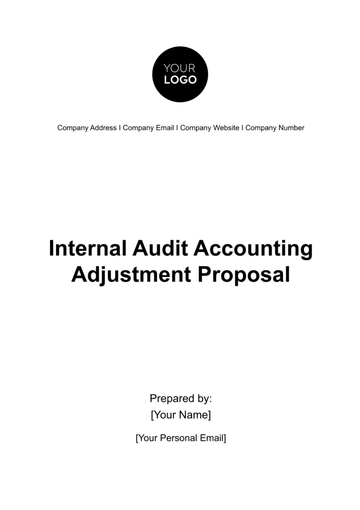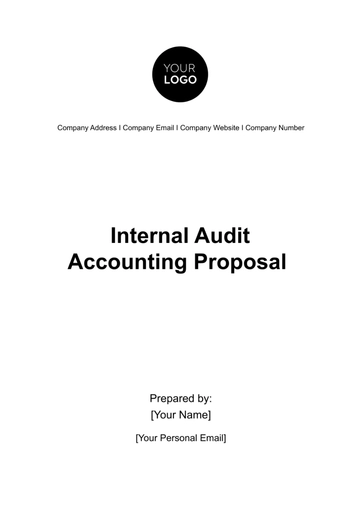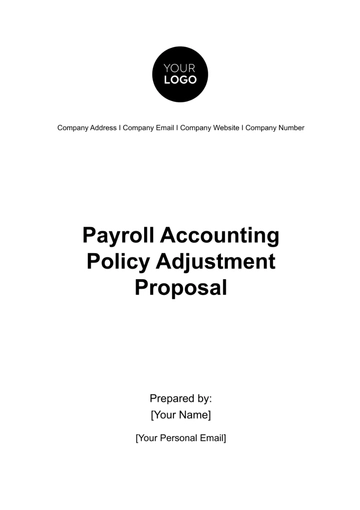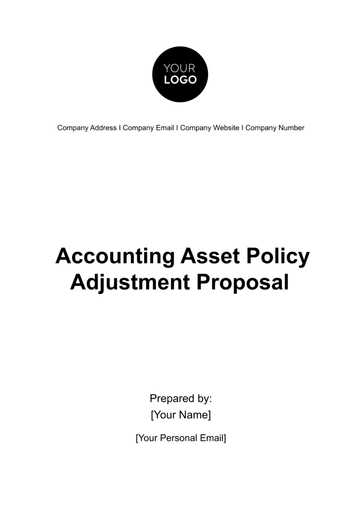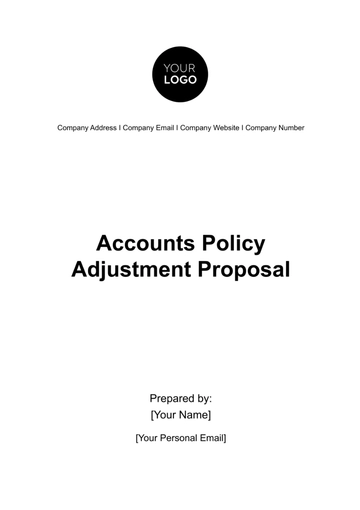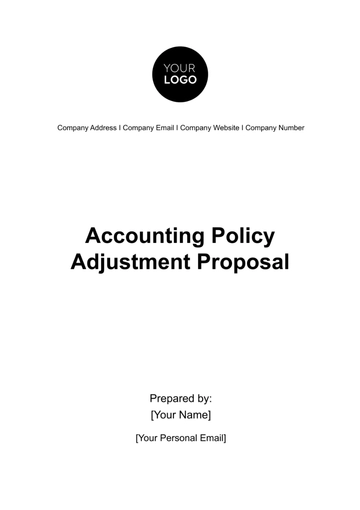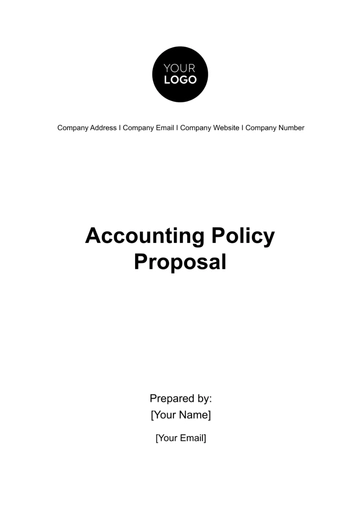Free Internal Audit Accounting Adjustment Proposal
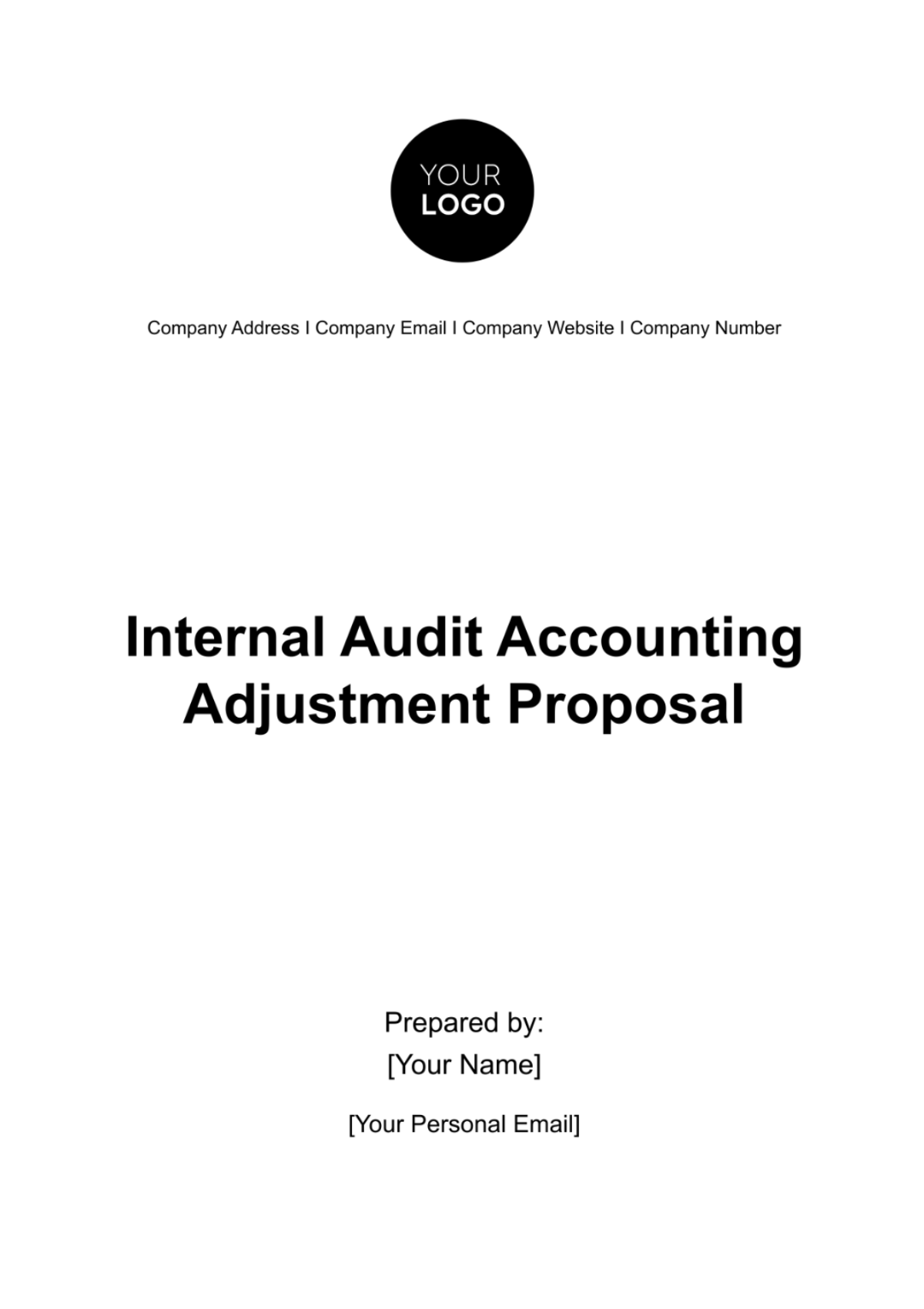
Executive Summary
This proposal is the culmination of a thorough internal audit conducted to assess the accuracy and compliance of our accounting practices. The audit identified several discrepancies that, if corrected, could significantly improve the reliability of our financial reporting and ensure compliance with applicable accounting standards. This document outlines key findings from the audit, proposes specific adjustments to our accounting records, and recommends changes to our accounting policies and procedures. The proposed adjustments focus on rectifying inaccuracies in revenue recognition, expense allocation, and asset valuation. Implementing these changes is expected to enhance the integrity of our financial statements and strengthen our internal controls. The executive team's approval and support are sought to implement these adjustments promptly and efficiently.
Introduction
The internal audit was initiated on [Insert Date] with the objective of evaluating the accuracy, completeness, and compliance of our financial transactions and reporting processes. The scope of the audit encompassed all major financial areas, including revenue, expenses, assets, and liabilities, for the fiscal year ending [Insert Fiscal Year End Date]. Through a comprehensive review of our accounting records, interviews with relevant personnel, and analysis of financial processes, the audit aimed to identify any discrepancies, non-compliance issues, or opportunities for improvement.
The audit process was guided by industry best practices, relevant accounting standards, and regulatory requirements. It involved a detailed examination of transactional records, reconciliation processes, and the effectiveness of internal controls designed to safeguard the accuracy and integrity of our financial reporting.
The findings from this audit have led to the development of this proposal, which outlines specific adjustments needed to address the identified discrepancies and recommendations for enhancing our accounting policies and procedures. The following sections detail the audit findings, proposed adjustments, and the rationale behind each recommendation, culminating in a plan for implementing these changes and assessing their financial impact.
Audit Findings
During the internal audit, we uncovered several discrepancies that could impact the accuracy of our financial statements and our compliance with accounting standards. These findings are critical to address to ensure the integrity of our financial reporting and maintain stakeholder confidence.
Finding ID | Description | Value Impact (USD) | Area Affected |
001 | Overstatement of revenue due to premature revenue recognition | 150,000 | Revenue |
002 | Understatement of expenses related to delayed accruals | 75,000 | Expenses |
003 | Misclassification of capital expenditures as operational expenses | 50,000 | Assets/ Expenses |
004 | Inadequate provision for doubtful debts leading to overstated receivables | 25,000 | Receivables |
Analysis of the Impact of These Findings
The discrepancies identified through the internal audit have significant implications for our financial statements and overall financial health. The overstatement of revenue (Finding ID 001) by $150,000 could mislead stakeholders about our profitability and cash flow situation, potentially affecting investment decisions and valuations. Similarly, the understatement of expenses (Finding ID 002) by $75,000 impacts our expense management and could lead to budgetary imbalances and distorted profit margins.
The misclassification of capital expenditures (Finding ID 003) as operational expenses not only affects the accuracy of our expense reporting but also our asset valuation and depreciation calculations, leading to further inaccuracies in future financial periods. Lastly, the inadequate provision for doubtful debts (Finding ID 004) risks overstating our financial position by $25,000 and may result in unexpected financial adjustments when these debts are recognized.
Collectively, these findings highlight areas of risk within our accounting practices that require immediate attention. Failing to address these issues promptly could lead to regulatory penalties, damage to our reputation, and erosion of stakeholder trust. The next sections will detail the specific adjustments proposed to rectify these discrepancies and recommendations to prevent their recurrence.
Adjustment Proposals
Based on the findings from our internal audit, we propose the following adjustments to our accounting records and practices:
Revenue Recognition Adjustment: To correct the overstatement of revenue by $150,000 due to premature recognition, we propose adjusting our revenue entries to align with the delivery of goods and services, as per the matching principle. This adjustment will ensure that revenue is recognized in the correct accounting period.
Expense Recognition Adjustment: To address the $75,000 understatement of expenses related to delayed accruals, we recommend adjusting our expense records to reflect the accrual basis of accounting accurately. This involves recognizing expenses when they are incurred, regardless of when the cash is paid.
Reclassification of Capital Expenditures: The $50,000 misclassified as operational expenses should be correctly classified as capital expenditures. This reclassification requires adjusting our asset ledger to include these expenditures and adjusting future depreciation schedules accordingly.
Adjustment for Doubtful Debts: To correct the inadequate provision for doubtful debts, which led to overstated receivables by $25,000, we propose increasing our allowance for doubtful accounts. This adjustment will more accurately reflect the potential uncollectability of certain receivables.
Rationale for Adjustments
These proposed adjustments are critical for ensuring the accuracy and reliability of our financial statements, enhancing our compliance with accounting standards, and maintaining the trust of our stakeholders. The table below outlines the benefits and values of the proposed changes:
Adjustment Proposal | Benefit/Value |
Revenue Recognition Adjustment | Ensures revenue is accurately matched with the period it is earned, enhancing the reliability of profit reporting. |
Expense Recognition Adjustment | Aligns expenses with the periods in which they are incurred, providing a true reflection of financial performance. |
Reclassification of Capital Expenditures | Corrects asset valuation and depreciation, impacting future financial statements positively. |
Adjustment for Doubtful Debts | Provides a more realistic view of receivables, enhancing the accuracy of the balance sheet. |
Implementing these adjustments will not only rectify the discrepancies identified but also strengthen our financial governance by improving the transparency and accuracy of our accounting practices. These changes are expected to have a positive impact on our financial statements, reducing the risk of errors and ensuring compliance with accounting standards. Furthermore, by addressing these issues proactively, we can avoid potential regulatory scrutiny and reinforce our commitment to financial integrity.
Implementation Plan
To effectively implement the proposed adjustments, a detailed plan has been developed. This plan outlines the specific steps required, the timeline for completion, and the responsibilities assigned to each task. The aim is to ensure a seamless integration of these changes with minimal disruption to our ongoing operations.
Step | Month | Responsibility |
Review and approve adjustment proposals | Month 1 | Executive Team |
Adjust revenue recognition entries | Month 2 | Accounting Department |
Reclassify capital expenditures | Month 2 | Asset Management Team |
Update and apply new expense recognition criteria | Month 3 | Finance Department |
Increase allowance for doubtful debts | Month 3 | Accounts Receivable Team |
Communicate changes to relevant stakeholders | Month 4 | Internal Communications Team |
Review implementation effectiveness | Month 6 | Internal Audit Team |
Financial Impact Analysis
The proposed adjustments are expected to have a significant impact on our financial statements. The table below outlines the changes in values resulting from these adjustments.
Adjustment | Change in Value (USD) | Impact on Financial Statement |
Revenue Recognition Adjustment | -150,000 | Decrease in reported revenue |
Expense Recognition Adjustment | +75,000 | Increase in reported expenses |
Reclassification of Capital Expenditures | +50,000 | Increase in asset value, decrease in current period expenses |
Adjustment for Doubtful Debts | -25,000 | Decrease in net receivables |
Analysis of the Impact of These Changes
The adjustments will lead to a more accurate representation of our financial position. The reduction in reported revenue and the increase in reported expenses will result in a lower net income for the fiscal year. However, this adjustment reflects a more realistic and sustainable financial performance. Reclassifying capital expenditures will not only correct the misclassification error but also impact future depreciation calculations, leading to more accurate expense recognition over the assets' useful lives. The increase in the allowance for doubtful debts will decrease net receivables, aligning our balance sheet with a more conservative and realistic view of potential cash inflows.
Overall, these adjustments are expected to enhance the integrity and reliability of our financial reporting. While there may be a short-term impact on reported earnings, these changes are crucial for ensuring long-term financial health and compliance with accounting standards. The adjustments will also likely improve stakeholder confidence by demonstrating our commitment to accurate and transparent financial reporting.
Risk Assessment
Implementing the proposed accounting adjustments necessitates a careful evaluation of associated risks to ensure that the organization is prepared to address any challenges effectively. This risk assessment considers the likelihood and potential impact of risks related to the implementation process and proposes mitigation strategies to minimize their effects.
Risk | Likelihood | Impact | Mitigation Strategy |
Stakeholder Resistance | Medium | High | Engage stakeholders early, explaining the benefits and necessity of adjustments. |
Disruption to Financial Reporting | Low | Medium | Plan adjustments for a period of low financial activity; provide training to relevant staff. |
Implementation Delays | Medium | Medium | Establish clear timelines and responsibilities; monitor progress closely. |
Potential for Error in Adjustments | Low | High | Conduct thorough reviews and audits of adjustments; involve experienced personnel. |
Regulatory Compliance Concerns | Low | High | Consult with legal and compliance experts to ensure all adjustments meet regulatory standards. |
Analysis of the Impact of These Risks
The identified risks, while manageable, could impact the successful implementation of the proposed accounting adjustments if not addressed properly. Stakeholder resistance can be mitigated through effective communication and engagement, ensuring that all parties understand the need for and benefits of the adjustments. Potential disruptions to financial reporting and the risk of implementation delays can be minimized with careful planning, adequate training, and constant monitoring. The risk of errors in implementing the adjustments underscores the importance of involving experienced personnel and conducting detailed reviews. Lastly, regulatory compliance concerns can be alleviated by consulting with legal and compliance experts, ensuring that all adjustments are in line with current standards and regulations. By proactively addressing these risks, we can ensure a smooth implementation process and safeguard the integrity of our financial reporting.
Conclusion
The proposed accounting adjustments outlined in this proposal are essential for correcting discrepancies identified during our internal audit and for enhancing the accuracy and reliability of our financial reporting. By implementing these adjustments, we not only comply with accounting standards but also reinforce our commitment to financial transparency and integrity. The detailed implementation plan and financial impact analysis provided in this proposal demonstrate our readiness to undertake these adjustments in a manner that minimizes disruption to our operations and addresses potential risks effectively. We seek the executive team's approval to proceed with these critical adjustments, confident in our ability to manage the process efficiently and with the utmost attention to detail. This proposal represents a significant step toward strengthening our financial governance and ensuring the long-term success and stability of our organization.
- 100% Customizable, free editor
- Access 1 Million+ Templates, photo’s & graphics
- Download or share as a template
- Click and replace photos, graphics, text, backgrounds
- Resize, crop, AI write & more
- Access advanced editor
Facilitate effective audit adjustments with the Internal Audit Accounting Adjustment Proposal Template from Template.net. This editable and customizable template is designed to streamline the proposal of necessary adjustments following an audit. Editable in our AI Editor tool, it offers unparalleled flexibility for tailoring content to meet specific audit findings and recommendations. Ideal for auditors.
You may also like
- Business Proposal
- Research Proposal
- Proposal Request
- Project Proposal
- Grant Proposal
- Photography Proposal
- Job Proposal
- Budget Proposal
- Marketing Proposal
- Branding Proposal
- Advertising Proposal
- Sales Proposal
- Startup Proposal
- Event Proposal
- Creative Proposal
- Restaurant Proposal
- Blank Proposal
- One Page Proposal
- Proposal Report
- IT Proposal
- Non Profit Proposal
- Training Proposal
- Construction Proposal
- School Proposal
- Cleaning Proposal
- Contract Proposal
- HR Proposal
- Travel Agency Proposal
- Small Business Proposal
- Investment Proposal
- Bid Proposal
- Retail Business Proposal
- Sponsorship Proposal
- Academic Proposal
- Partnership Proposal
- Work Proposal
- Agency Proposal
- University Proposal
- Accounting Proposal
- Real Estate Proposal
- Hotel Proposal
- Product Proposal
- Advertising Agency Proposal
- Development Proposal
- Loan Proposal
- Website Proposal
- Nursing Home Proposal
- Financial Proposal
- Salon Proposal
- Freelancer Proposal
- Funding Proposal
- Work from Home Proposal
- Company Proposal
- Consulting Proposal
- Educational Proposal
- Construction Bid Proposal
- Interior Design Proposal
- New Product Proposal
- Sports Proposal
- Corporate Proposal
- Food Proposal
- Property Proposal
- Maintenance Proposal
- Purchase Proposal
- Rental Proposal
- Recruitment Proposal
- Social Media Proposal
- Travel Proposal
- Trip Proposal
- Software Proposal
- Conference Proposal
- Graphic Design Proposal
- Law Firm Proposal
- Medical Proposal
- Music Proposal
- Pricing Proposal
- SEO Proposal
- Strategy Proposal
- Technical Proposal
- Coaching Proposal
- Ecommerce Proposal
- Fundraising Proposal
- Landscaping Proposal
- Charity Proposal
- Contractor Proposal
- Exhibition Proposal
- Art Proposal
- Mobile Proposal
- Equipment Proposal
- Student Proposal
- Engineering Proposal
- Business Proposal




